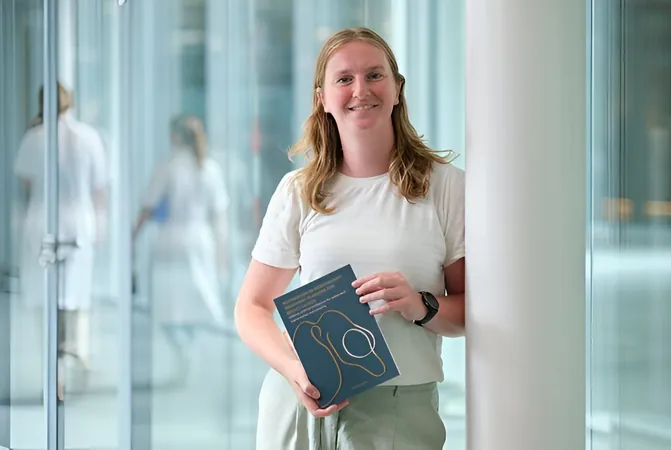
The Urgent Need for Improved Cardiovascular Care for Women: Key Insights from a British Consensus Statement
2024-09-26
A Groundbreaking Consensus Statement
A groundbreaking consensus statement from the British Cardiovascular Society (BCS) highlights ongoing, critical disparities in cardiovascular care for women, stressing that significant efforts must be made to enhance treatment options and outcomes. Despite escalating awareness, the issue remains largely unaddressed, with ischemic heart disease continuing to be the leading cause of death among women.
Lead author Vijay Kunadian, MBBS, MD, from Newcastle University, had also served on the Lancet commission that aimed to reduce the global burden of heart disease among women by one-third by the year 2030. Four years have passed since that bold call to action, and unfortunately, little progress has been made.
Kunadian candidly remarks, "Statistics show that ischemic heart disease continues to kill women at alarming rates, and many are still underserved in terms of medication and treatment compared to men. Women remain underrepresented in clinical research, which translates to insufficient care."
The purpose of this newly released consensus statement is to maintain a spotlight on these disparities, urging stakeholders to address the specific healthcare needs of women. By bringing together 21 societies affiliated with the BCS, the statement offers actionable recommendations designed to improve care across various cardiovascular diseases and treatment settings.
"We must unite to tackle the comprehensive issue of cardiovascular health in women," said Kunadian, who leads research and development for the British Cardiovascular Intervention Society. She emphasizes the need for equitable access to specialists and screening, particularly for conditions that uniquely affect women.
A Focused Approach on Women's Unique Health Needs
This recent consensus, published in the journal Heart and led by Upasana Tayal, BMBCh, PhD from Imperial College London, examines traditional risk factors through a female lens, including problems specifically tied to women, like hormonal changes during menopause.
The paper explores several cardiovascular disease areas and service types, such as coronary artery disease (CAD), heart rhythm disorders, cardio-oncology, and more. Key “action points” have been proposed to address inadequacies in women’s cardiovascular care from both patient and nursing perspectives.
The authors clarify that their recommendations prioritize biological sex distinctions, given the pathophysiological differences in cardiovascular disease influenced by reproductive hormones and anatomy. However, they also acknowledge the value of a gender-based analysis to consider social factors and lifestyle choices that might affect women's risk.
Despite decades of discussion around these inequalities, tangible changes have yet to materialize. Kunadian reflects, "We've been echoing these concerns for years, yet progress has been disappointingly slow."
Surveys reveal that women are consistently under-prescribed treatments and are less likely to undergo necessary procedures such as invasive coronary angiography after a heart attack. Kunadian urges those involved in cardiovascular health to lean into the conversation and take proactive steps to address these women-specific conditions, ultimately aiming to reduce the mortality gap between genders, especially following myocardial infarctions.
Guideline committees are finally beginning to include women-specific recommendations in European guidance documents concerning acute coronary syndromes, which Kunadian has contributed to directly. This marks a crucial shift toward recognizing and addressing the disparities in treatment women face.
Moreover, there’s an emphasis on properly following up with women who experience pregnancy-related conditions, such as preeclampsia or gestational diabetes, which indicate heightened future cardiovascular risks. Kunadian stresses that addressing these risk factors early on can prevent severe diseases from manifesting later in life.
Crucially, healthcare providers need to take women's concerns seriously when they seek help with potential cardiovascular issues. Kunadian notes, "Patient-provider communication can sometimes take longer, especially with female patients. But investing that time is essential to accurately diagnose and treat their conditions."
Finally, increasing the representation of women in cardiovascular research is vital. Positive strides are being made, as demonstrated by ongoing trials like the SMART trial and the RHEIA trial, both of which feature predominantly female participant groups. These developments signal a growing recognition of the need for tailored research addressing the health needs of women.
As the landscape shifts, it's more crucial than ever to understand the distinct cardiovascular health challenges women face – and address them with the urgency they deserve.



 Brasil (PT)
Brasil (PT)
 Canada (EN)
Canada (EN)
 Chile (ES)
Chile (ES)
 España (ES)
España (ES)
 France (FR)
France (FR)
 Hong Kong (EN)
Hong Kong (EN)
 Italia (IT)
Italia (IT)
 日本 (JA)
日本 (JA)
 Magyarország (HU)
Magyarország (HU)
 Norge (NO)
Norge (NO)
 Polska (PL)
Polska (PL)
 Schweiz (DE)
Schweiz (DE)
 Singapore (EN)
Singapore (EN)
 Sverige (SV)
Sverige (SV)
 Suomi (FI)
Suomi (FI)
 Türkiye (TR)
Türkiye (TR)